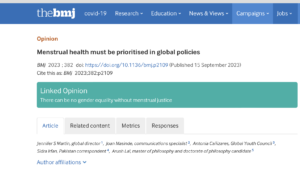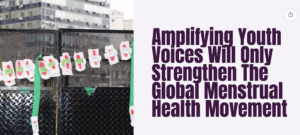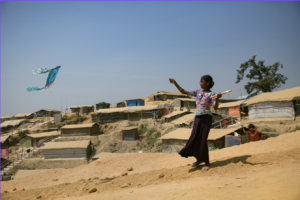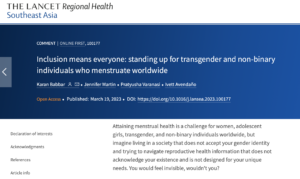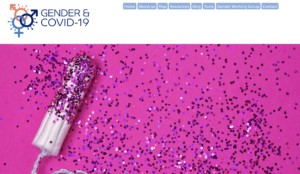Menstrual health is central to achieving universal health coverage (UHC), and is an integral part of attaining several United Nations Sustainable Development Goals (SDGs), including SDG 1: No Poverty, SDG 3: Enhancing Health and Well-being, SDG 5: Gender Equality, SGD 8: Decent Work and Economic Growth, SDG 10: Reduced Inequalities, SDG 12: Sustainable Consumption and Production, and SDG 12: Climate Action. It also underpins several human rights such as access to water, sexual and reproductive health rights, education, and the ability to live in environments free of stigma and shame.
During the 78th session of the United Nations General Assembly (UNGA), the latest Political Declaration on Universal Health Coverage (2023) omitted several of the commitments that preserved sexual and reproductive health rights (SRHR) from the 2019 declaration. As SRHR and bodily autonomy become increasingly politicised, Pandemic Periods is committed to elevating menstrual health as a gateway to socialising governments to broader SRHR, accelerating progress to multiple SDGs, and delivering human rights and health for all.
The 1948 WHO Constitution placed UHC at the forefront of health policy recommendations, stating that the ‘enjoyment of the highest attainable standard of health is one of the fundamental rights of every human…’. According to the World Health Organization (2023), UHC is defined as ‘all people have access to the full range of quality health services they need, when and where they need them, without financial hardship.’”
Menstrual health is not explicitly referenced in the SDGs 2023, and the failure to explicitly recognise menstrual health as part of these efforts is a poignant and significant omission. There must be a renewed global effort to speak about SRHR and menstruation in international settings to encourage unwavering support for menstrual health issues.
“Discussing menstruation on a global stage can help to lay the groundwork for broader conversations around sexual and reproductive health in the community, workplace, education, and families, and at the individual level, can help to create a common vernacular and language for younger populations to discuss these issues openly, without shame.”
On December 12, 2012, the UNGA adopted a resolution (67/81) focusing on global health and foreign policy, asking countries to “accelerate progress toward universal health coverage”. Five years later, on December 12, 2017, the General Assembly passed another resolution (72/139) focused on “addressing the health of the most vulnerable for an inclusive society”. This resolution called on UN Member States to engage with a variety of stakeholders and advocate for international UHC. Since then, December 12th has been named International Universal Health Coverage Day. This day, according to the UN, aims to “raise awareness of the need for strong and resilient health systems and universal health coverage with multi-stakeholder partners”.
For women, adolescent girls, transgender men, and non-binary people who menstruate, UHC must include menstrual, sexual, and reproductive health in all its forms, including comprehensive sexuality education, access to WASH facilities, and provision of health services in environments free of stigma and shame.. It is documented that ‘in 2021, about 4.5 billion people were not fully covered by essential health services,’ and with a global population of 8.1 billion, that’s nearly one in every two people.
There is clearly still work to be done!
With increased focus and funding for UHC, these underscored barriers will have less of an impact on vulnerable populations of women, adolescent girls, and people who menstruate by providing them timely access to the comprehensive care that everyone is entitled to under the WHO Constitution. The disproportionate impact of the COVID-19 pandemic on the world’s most vulnerable groups has not been internationally recognised to the extent necessary to achieve global change on this issue, and Pandemic Periods is dedicated to making significant contributions to the global conversation.
Some countries have made progress in achieving UHC, and serve as tangible and attainable examples of integrated menstrual health policy for the world to emulate. We outline some of these country case studies below, and aim to highlight both their flaws and their successes to paint a picture of a world in which the challenges of menstruation are alleviated by UHC.
Country Case Studies
Norway
Norway’s health system is dominated by public sectors and is available to the population and it became a universal health service in 1956. The government is responsible for funding, regulating, and overseeing the provision of care. Municipalities and counties organise public health initiatives involving health promotion. Universal health care in Norway covers primary and ambulatory care, mental health care, long-term hospital care, preventative and rehabilitation services, maternal and child care, and home-based and palliative care. In the State of Health in the EU by OECD/European Observatory, published in 2021, Norway ranked the highest in terms of life expectancy (83.3 years) and health spending; had the lowest rates of death due to preventable and treatable causes and had relatively lower death rates during the second COVID19 wave than the first compared to rest of Europe. Despite the extraordinary success of the healthcare system, language pertaining to menstrual health has not been used in the context of sexual and reproductive health.
A qualitative study that examined the view of female reproductive issues in Norwegian women concluded that even though the Norwegian healthcare system ranks well globally, there is a lack of research in areas such as Premenstrual Syndrome (PMS) and Pre-Menstrual Dysmorphic Disorder (PMDD) and the effect of endometriosis on not just women’s health, but also several different mental and social implications. The participants’ perceptions were the limited knowledge of primary health care and the existence of stigma associated with conditions related to menstruation. This translated to menstrual health issues not being prioritised in Norwegian primary care, despite GPs being the first point of contact.
Taiwan
Implemented in 1995, the National Health Insurance (NHI) system of Taiwan is a mandatory, universal health coverage system funded through payroll-based premiums with subsidies available for low-income households, civil servants, and others. This structure ensures equity in access to all medical and healthcare services for all ailments. Unlike in Norway, the municipal governments have no role in the provision of healthcare. Services like visual acuity tests or the provision of eyeglasses, wheelchairs, and hearing aids are not covered by the system.
In 2022, the public and private sectors in Taiwan joined hands to lend support to students from disadvantaged backgrounds to go through puberty. The project intended to supply free period products and provide talks to increase awareness and eliminate stigma on educational campuses. From August 1st, 2023, the country made free period products available in all schools along with subsidies for low-income students to independently purchase supplies as needed.
Ukraine
The health system of Ukraine transitioned in 1991 from a hierarchical nationally controlled system known as the Semashko system. At present, the system consists of a “package of healthcare services provided free of charge at the point of use as a constitutional right”. It is funded partially through general taxation and partially through out-of-pocket payments.
In the war that started in February of 2022, access to health services for cervical cancer, HIV treatment, and safe abortions was of particular concern to menstrual health advocates, due to many hospitals being overwhelmed by conflict injuries and acting as bomb shelters. Navigating menstruation in an active conflict zone can be a challenge due to the dwindling availability of products and of sanitation, thereby jeopardising the health and safety of all who menstruate. Despite the active and ongoing conflict, there are efforts being made by humanitarian aid organisations such as the UNFPA to alleviate the arresting barriers to access to sexual, reproductive, and menstrual care in the country.
A recent study on the impact of war on menstruation in Ukraine identified longer, heavier, and more frequent menstruation in female military personnel with head injuries, caused by changes in hormonal balance and endometrial pathology. However, because the study was conducted in a specific population and a very small sample size of non-military civilians, these findings cannot be generalised to the wider Ukrainian population.
Policy Recommendations
To achieve UHC for the world, there must be international commitment and collaboration to efforts that are already ongoing, such as the UHC2030 Campaign and the European Patients Forum on UHC. We provide three key policy recommendations that we believe will bring healthcare to all and specifically address the needs of people who menstruate.
1. The UN Member States must continue to prioritise action on achieving the sustainable development goals.
The deadlines for the upcoming 2030 SDG deadline have been impeded by the global pandemic, armed conflict, and the rise of ableism, nationalism, sexism, racism, and xenophobia. Without continued and public reaffirmation of the SDGs, nations will continue to deprioritise global health issues and fail to support their most vulnerable populations. It is imperative that the 2030 targets be met to ensure global menstrual equity.
2. The world must amend the language surrounding menstrual health to explicitly recognise it as a distinct public health issue.
Menstruation tends to be combined with other issues such as SRHR, WASH, adolescent health, or education, but menstrual health is a separate public health issue and should be recognised as such. Without this distinction, menstrual health will remain deprioritized within SRHR conversations, and the world will continue to fail to act on the menstrual inequalities that persist. Language is key, and standardising it must become a priority to achieve universal action on menstrual health inequalities.
3. Grassroots organisations must inform UHC efforts and campaigns to alter societal stigma around menstrual.
We know that top-down approaches to sensitive health issues such as menstrual, sexual, and reproductive health do not stand the test of time. In order to create long-lasting changes that are effective in the communities they are impacting, their structures and facets should be informed by those who are most involved in the grassroots-level work. Involving the voices of women, girls, and gender-diverse people who menstruate is the key to unlocking a future of menstrual equity for all. The subsequent societal shifts and public support will ensure that policies are adopted by health systems, and financed through donors, as well as governments.
Pandemic Periods is committed to furthering UHC to alleviate the menstrual health inequalities that persist globally. Our aim is to champion menstruation health for women, adolescent girls, and all who menstruate by elevating it as a human rights and a public health issue. Our grassroots voices drive and diversify the global menstrual health narrative, and will continue to advocate for menstrual health as a solution to socialising governments around broader SRHR, accelerating progress to the SDGs, and furthering human rights.


